February 19, 2010
Retail Sales
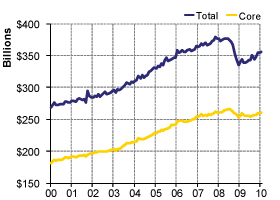 Consumers are getting back in the game. Total retail and food sales increased in January by 0.5 percent, seasonally adjusted, while core sales, which exclude autos and gas, rose by 0.6 percent. During the 12 months ending in January, total and core sales increased by 4.7 and 2.0 percent, respectively, with total sales boosted by the cash-for-clunkers program. Nevertheless, total sales remain 6.3 percent below their recent peak, and core sales are still down by 2.2 percent. As the labor market begins to improve, consumers will carefully ramp up their spending, including some purchases that were deferred during the depths of the recession. Consumer spending accounts for about 70 percent of total gross domestic product, so even a sluggish recovery in retail sales will help put a floor under the economy and reduce the chances for a double-dip recession. This will support leasing demand for commercial real estate, particularly shopping centers. Source: Census Bureau, Grubb & Ellis
Consumers are getting back in the game. Total retail and food sales increased in January by 0.5 percent, seasonally adjusted, while core sales, which exclude autos and gas, rose by 0.6 percent. During the 12 months ending in January, total and core sales increased by 4.7 and 2.0 percent, respectively, with total sales boosted by the cash-for-clunkers program. Nevertheless, total sales remain 6.3 percent below their recent peak, and core sales are still down by 2.2 percent. As the labor market begins to improve, consumers will carefully ramp up their spending, including some purchases that were deferred during the depths of the recession. Consumer spending accounts for about 70 percent of total gross domestic product, so even a sluggish recovery in retail sales will help put a floor under the economy and reduce the chances for a double-dip recession. This will support leasing demand for commercial real estate, particularly shopping centers. Source: Census Bureau, Grubb & Ellis
For a free consultation of your commercial real estate needs please contact Sean Thompson at 406.539.0082 or sean.thompson@mtcommercialre.com OR Joe Cobb at 406.579.2999 or joe.cobb@mtcommercialre.com. www.MTcommercialRE.com
 Leave a Comment » |
Leave a Comment » |  Market Reports | Tagged: Belgrade Commercial Real Estate, Belgrade Office, Bozeman, Bozeman Business, Bozeman Commercial Land, Bozeman Commercial Real Estate, Bozeman Office, Bozeman Real Estate, Bozeman Retail, Bozeman Warehouse, Commercial Investment, Commercial Real Estate, Commercial Real Estate Bozeman, Grubb & Ellis, Investment Property, Montana Business, Montana Commercial, Montana Commercial Real Estate, Montana Real Estate, Retail For Lease, Retail For Sale, Retail Lease |
Market Reports | Tagged: Belgrade Commercial Real Estate, Belgrade Office, Bozeman, Bozeman Business, Bozeman Commercial Land, Bozeman Commercial Real Estate, Bozeman Office, Bozeman Real Estate, Bozeman Retail, Bozeman Warehouse, Commercial Investment, Commercial Real Estate, Commercial Real Estate Bozeman, Grubb & Ellis, Investment Property, Montana Business, Montana Commercial, Montana Commercial Real Estate, Montana Real Estate, Retail For Lease, Retail For Sale, Retail Lease |  Permalink
Permalink
 Posted by Sean Thompson
Posted by Sean Thompson
January 22, 2010
Signs of a Market Bottom…
Office and industrial vacancy rates increased every quarter last year, but the rate of increase declined as the year progressed. In the four quarters of 2009, office vacancy increased sequentially by 80, 100, 50 and 30 basis points while industrial vacancy increased by 70, 60, 30 and 20 basis points. Absorption followed a similar trajectory: Totals were negative every quarter last year, but fourth quarter losses were the shallowest.
We are hearing about other signs of a market bottom:
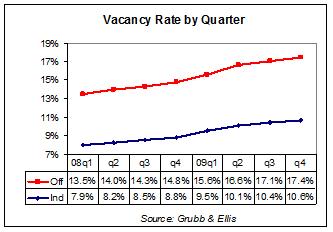 This could be the year of the long-term lease, replacing the one-year extensions prevalent in 2009. Tenants whose leases expired last year shied away from new long-term commitments given the bleak outlook. But the economy has started to grow again, and profits held up remarkably well through the recession thanks to corporate cost-cutting measures including employee layoffs. Tenants are becoming confident enough to lock in the great deals on offer from landlords.
This could be the year of the long-term lease, replacing the one-year extensions prevalent in 2009. Tenants whose leases expired last year shied away from new long-term commitments given the bleak outlook. But the economy has started to grow again, and profits held up remarkably well through the recession thanks to corporate cost-cutting measures including employee layoffs. Tenants are becoming confident enough to lock in the great deals on offer from landlords. - Tenants’ top priority last year was getting the cheapest space, but many tenants are becoming receptive to upgrading their space, i.e. willing to pay a little more for better space. In the retail market, some tenants were shut out of the best locations during the boom. But vacancies have opened up even in the best centers, and retailers are looking at upgrading their locations.
- In a few markets, landlord psychology is beginning to shift. The office vacancy rate continues to rise in San Francisco, but some property owners have reduced their concession packages, believing the worst has passed.
- Industrial brokers in some locations including Tampa and Columbus are reporting increasing activity by tenants looking to take advantage of very low rental rates.
Courtesy of Robert Bach, SVP, Chief Economist, Grubb & Ellis
For a free consultation of your commercial real estate needs please contact Sean Thompson at 406.539.0082 or sean.thompson@mtcommercialre.com OR Joe Cobb at 406.579.2999 or joe.cobb@mtcommercialre.com. www.MTcommercialRE.com
 Leave a Comment » |
Leave a Comment » |  Market Reports | Tagged: Belgrade Buisness, Belgrade Commercial Real Estate, Belgrade Office, Bozeman, Bozeman Business, Bozeman Commercial Land, Bozeman Commercial Real Estate, Bozeman Office, Bozeman Real Estate, Bozeman Retail, Bozeman Warehouse, Commercial Investment, Commercial Real Estate, Commercial Real Estate Bozeman, Commercial Real Estate Forecast, Grubb & Ellis, Montana Business, Montana Commercial, Montana Commercial Real Estate, Montana Real Estate, Office For Lease, Office For Sale, Retail For Lease, Retail For Sale, Retail Lease, Warehouse For Lease, Warehouse For Sale |
Market Reports | Tagged: Belgrade Buisness, Belgrade Commercial Real Estate, Belgrade Office, Bozeman, Bozeman Business, Bozeman Commercial Land, Bozeman Commercial Real Estate, Bozeman Office, Bozeman Real Estate, Bozeman Retail, Bozeman Warehouse, Commercial Investment, Commercial Real Estate, Commercial Real Estate Bozeman, Commercial Real Estate Forecast, Grubb & Ellis, Montana Business, Montana Commercial, Montana Commercial Real Estate, Montana Real Estate, Office For Lease, Office For Sale, Retail For Lease, Retail For Sale, Retail Lease, Warehouse For Lease, Warehouse For Sale |  Permalink
Permalink
 Posted by Sean Thompson
Posted by Sean Thompson
January 19, 2010
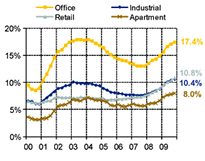
Commercial Real Estate Vacancy Rates
The average U.S. vacancy rates for the four core property types – office, industrial, retail and apartment – continued to rise in the fourth quarter, but the rate of increase slowed for office and industrial. Vacancy rates last quarter increased by 30 basis points for office and 20 basis points for industrial compared with third-quarter gains of 50 and 30 basis points, respectively. This raises the possibility that the office and industrial leasing markets may bottom out as early as mid-year with modest, positive absorption possible in the second half of 2010. In the office market, a prerequisite for this relatively early bottoming would be for employers to begin adding jobs in the first half of this year, which would also provide support for the apartment and retail markets. For the industrial market, continued improvement in the drivers of demand for industrial space – production activity, freight shipments and global trade – would help the market bottom out around mid-year. Source: Reis, Grubb & Ellis
For a free consultation of your commercial real estate needs please contact Sean Thompson at 406.539.0082 or sean.thompson@mtcommercialre.com OR Joe Cobb at 406.579.2999 or joe.cobb@mtcommercialre.com. www.MTcommercialRE.com
 Leave a Comment » |
Leave a Comment » |  Market Reports | Tagged: Belgrade Buisness, Belgrade Commercial Real Estate, Belgrade Office, Bozeman, Bozeman Business, Bozeman Commercial Land, Bozeman Commercial Real Estate, Bozeman Office, Bozeman Real Estate, Bozeman Retail, Bozeman Warehouse, Commercial Investment, Commercial Real Estate, Commercial Real Estate Bozeman, Montana Business, Montana Commercial, Montana Commercial Real Estate, Montana Real Estate, Office For Lease, Office For Sale, Retail For Lease, Retail For Sale, Retail Lease, Warehouse For Lease, Warehouse For Sale |
Market Reports | Tagged: Belgrade Buisness, Belgrade Commercial Real Estate, Belgrade Office, Bozeman, Bozeman Business, Bozeman Commercial Land, Bozeman Commercial Real Estate, Bozeman Office, Bozeman Real Estate, Bozeman Retail, Bozeman Warehouse, Commercial Investment, Commercial Real Estate, Commercial Real Estate Bozeman, Montana Business, Montana Commercial, Montana Commercial Real Estate, Montana Real Estate, Office For Lease, Office For Sale, Retail For Lease, Retail For Sale, Retail Lease, Warehouse For Lease, Warehouse For Sale |  Permalink
Permalink
 Posted by Sean Thompson
Posted by Sean Thompson
January 11, 2010
Commercial RE Loans at Commercial Banks
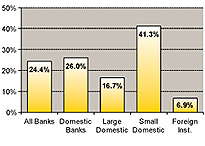
Percentage of All Bank Loans and Leases, November 2009
Commercial real estate loans accounted for 24 percent of all loans and leases at commercial banks in the U.S. as of November. The Federal Reserve defines these to include “construction, land development, and other land loans, and loans secured by farmland, multifamily (5 or more) residential properties, and nonfarm nonresidential properties.” Large domestically chartered banks – the 25 largest in terms of domestic assets – held 17 percent of their loans and leases in commercial real estate while small domestically chartered banks held 41 percent in this category. The preponderance of commercial real estate loans at small banks suggests more failures to come as distressed assets continue to accumulate. Moreover, small banks lend to small businesses, which are job incubators; commercial real estate loan problems at small banks could impinge upon their ability to lend, which could dampen the labor market recovery. Courtesy of Robert Bach, SVP, Chief Economist, Grubb & Ellis.
For a free consultation of your commercial real estate needs please contact Sean Thompson at 406.539.0082 or sean.thompson@grubb-ellis.com OR Joe Cobb at 406.579.2999 or joe.cobb@grubb-ellis.com. www.MTcommercialRE.com
 Leave a Comment » |
Leave a Comment » |  Market Reports | Tagged: Belgrade Buisness, Belgrade Commercial Real Estate, Belgrade Office, Bozeman, Bozeman Business, Bozeman Commercial Land, Bozeman Commercial Real Estate, Bozeman Office, Bozeman Real Estate, Bozeman Warehouse, Commercial Investment, Commercial Real Estate, Commercial Real Estate Bozeman, Montana Business, Montana Commercial Real Estate, Montana Real Estate, Office For Lease, Office For Sale, Retail For Lease, Retail Lease, Warehouse For Lease, Warehouse For Sale |
Market Reports | Tagged: Belgrade Buisness, Belgrade Commercial Real Estate, Belgrade Office, Bozeman, Bozeman Business, Bozeman Commercial Land, Bozeman Commercial Real Estate, Bozeman Office, Bozeman Real Estate, Bozeman Warehouse, Commercial Investment, Commercial Real Estate, Commercial Real Estate Bozeman, Montana Business, Montana Commercial Real Estate, Montana Real Estate, Office For Lease, Office For Sale, Retail For Lease, Retail Lease, Warehouse For Lease, Warehouse For Sale |  Permalink
Permalink
 Posted by Sean Thompson
Posted by Sean Thompson
December 28, 2009
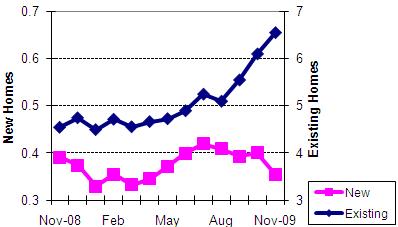
Home Sales In Millions. Source: Census Bureau, National Association of Realtors, Grubb & Ellis
Sales trends for new and existing homes parted company in November. The National Association of Realtors reported that existing home sales rose 7.4 percent from October to a seasonally adjusted annual rate of 6.54 million units, the highest level since February 2007. Meanwhile, the Census Bureau reported that new home sales sank to a seasonally adjusted annual rate of 355,000 units, down 11.3 percent from October and the weakest level in seven months. Sales of foreclosed and other distressed properties are inflating existing home sales at the expense of new home sales, having accounted for 33 percent of existing sales last month. The tax credit for first-time buyers, which was set to expire at the end of November, helped both new and existing home sales. But new home sales are counted when the sales contract is signed or a deposit is accepted while existing home sales are counted when the sale is closed, meaning that new home sales attributable to the tax credit likely showed up earlier in the data. The extension of the tax credit through April 2010 and its expansion to include some repeat buyers will provide a boost to home sales as the spring selling season gets underway. Besides ending the tax credit next year, the government will wind down its purchases of mortgage-backed securities, which has helped keep mortgage rates low. The withdrawal of these support programs will be a test to see if the housing market can continue to recover on its own or whether there could be another leg down in prices as foreclosures continue to mount. Courtesy of Robert Bach, SVP, Chief Economist, Grubb & Ellis.
For a free consultation of your commercial real estate needs please contact Sean Thompson at 406.539.0082 or sean.thompson@grubb-ellis.com OR Joe Cobb at 406.579.299 or joe.cobb@grubb-ellis.com. www.MTcommercialRE.com
 Leave a Comment » |
Leave a Comment » |  Market Reports | Tagged: Belgrade Buisness, Belgrade Commercial Real Estate, Belgrade Office, Bozeman, Bozeman Business, Bozeman Commercial Land, Bozeman Commercial Real Estate, Bozeman Office, Bozeman Real Estate, Bozeman Retail, Bozeman Warehouse, Commercial Investment, Commercial Real Estate, Commercial Real Estate Bozeman, Commercial Real Estate Forecast, Grubb & Ellis, Montana Business, Montana Commercial, Montana Commercial Real Estate, Montana Real Estate, Office For Lease, Office For Sale, Retail For Lease, Retail For Sale, Retail Lease, Warehouse For Lease, Warehouse For Sale |
Market Reports | Tagged: Belgrade Buisness, Belgrade Commercial Real Estate, Belgrade Office, Bozeman, Bozeman Business, Bozeman Commercial Land, Bozeman Commercial Real Estate, Bozeman Office, Bozeman Real Estate, Bozeman Retail, Bozeman Warehouse, Commercial Investment, Commercial Real Estate, Commercial Real Estate Bozeman, Commercial Real Estate Forecast, Grubb & Ellis, Montana Business, Montana Commercial, Montana Commercial Real Estate, Montana Real Estate, Office For Lease, Office For Sale, Retail For Lease, Retail For Sale, Retail Lease, Warehouse For Lease, Warehouse For Sale |  Permalink
Permalink
 Posted by Sean Thompson
Posted by Sean Thompson
December 21, 2009
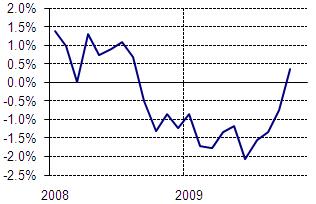 Percent Change Prior Month, Seasonally Adjusted Wholesale inventories, one of the less “glamorous” economic indicators, increased in October for the first time in 14 months. Businesses have been paring inventories at a furious pace since fall 2008 when the credit markets seized up and the recession worsened. With businesses not replenishing their inventories, production activity slowed and workers had their hours cut or were laid off. The cycle appears ready to swing the other way now as sales rose 1.2 percent in October, the sixth consecutive monthly gain. With sales rising and minimal inventories, companies will need to increase production, and there will be more goods flowing through corporate supply chains. This trend will support demand for industrial space, both manufacturing and warehouse-distribution space. Courtesy of Robert Bach, SVP, Chief Economist, Grubb & Ellis.
For a free consultation of your commercial real estate needs please contact Sean Thompson at 406-539-0082 or sean.thompson@grubb-ellis.com OR Joe Cobb at 406-579-2999 or joe.cobb@grubb-ellis.com. www.MTcommercialRE.com |
|
| |
 Leave a Comment » |
Leave a Comment » |  Market Reports | Tagged: Belgrade Buisness, Belgrade Commercial Real Estate, Belgrade Office, Bozeman, Bozeman Business, Bozeman Commercial Land, Bozeman Commercial Real Estate, Bozeman Real Estate, Bozeman Retail, Montana Commercial, Montana Commercial Real Estate |
Market Reports | Tagged: Belgrade Buisness, Belgrade Commercial Real Estate, Belgrade Office, Bozeman, Bozeman Business, Bozeman Commercial Land, Bozeman Commercial Real Estate, Bozeman Real Estate, Bozeman Retail, Montana Commercial, Montana Commercial Real Estate |  Permalink
Permalink
 Posted by Sean Thompson
Posted by Sean Thompson
December 18, 2009
Concluding Thoughts for 2009
Economic downturns can be an opportunity for savvy businesses to grab market share according to a story this week on NPR’s Morning Edition (click here to listen). The story notes that company market shares change more during a downturn than at any other time.
But this downturn is coming to a close. Former Federal Reserve Chairman Alan Greenspan, appearing on Meet the Press last Sunday, said that the recession probably ended in July or even in June. He went on to say that employers “presumed that the economy was going to go down far more sharply than it actually did… What this means is that we have a level of employment at this stage which is barely adequate to staff the level of output, and… it seems to me virtually inevitable that if nothing else were to happen that employment would start to come back fairly quickly.”
Alan Blinder, professor of economics and public affairs at Princeton University and a former vice chairman of the Federal Reserve Board, makes the same point in an op-ed article in The Wall Street Journal this week titled “The Case for Optimism on the Economy” (click here). He notes that “Fearful businesses pared payrolls to the bone… Which means that firms will need to hire more workers as their sales and production grow. Which means that employment may start growing sooner than the pessimists think.”
This is the 39th edition of Good News Friday. The first one came out on Friday, March 20th during the depths of the credit crisis and the recession. But we were already past the low point. The Dow Jones Industrial Average hit bottom on March 9th and embarked on what turned out to be a 57 percent rally as of yesterday, while net monthly job losses had peaked at 741,000 in January and were down just about every month since then, to 11,000 last month. Problems remain, of course, but the economy proved to be far more resilient than just about anyone thought.
Courtesy of Robert Bach, SVP, Chief Economist, Grubb & Ellis.
For a free consultation of your commercial real estate needs please contact Sean Thompson at 406.539.0082 or sean.thompson@grubb-ellis.com OR Joe Cobb at 406.579.2999 or joe.cobb@grubb-ellis.com. www.MTcommercialRE.com
 Leave a Comment » |
Leave a Comment » |  Market Reports | Tagged: Belgrade Buisness, Belgrade Commercial Real Estate, Belgrade Office, Bozeman, Bozeman Business, Bozeman Commercial Land, Bozeman Commercial Real Estate, Bozeman Real Estate, Bozeman Retail, Bozeman Warehouse, Commercial Investment, Commercial Real Estate, Commercial Real Estate Bozeman, Grubb & Ellis, Montana Business, Montana Commercial, Montana Commercial Real Estate, Montana Real Estate, Office For Lease, Office For Sale, Retail For Lease, Retail For Sale, Warehouse For Lease, Warehouse For Sale |
Market Reports | Tagged: Belgrade Buisness, Belgrade Commercial Real Estate, Belgrade Office, Bozeman, Bozeman Business, Bozeman Commercial Land, Bozeman Commercial Real Estate, Bozeman Real Estate, Bozeman Retail, Bozeman Warehouse, Commercial Investment, Commercial Real Estate, Commercial Real Estate Bozeman, Grubb & Ellis, Montana Business, Montana Commercial, Montana Commercial Real Estate, Montana Real Estate, Office For Lease, Office For Sale, Retail For Lease, Retail For Sale, Warehouse For Lease, Warehouse For Sale |  Permalink
Permalink
 Posted by Sean Thompson
Posted by Sean Thompson
December 14, 2009
Retail Sales
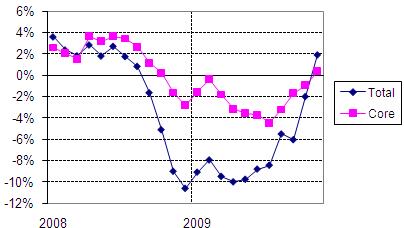
Year Over Year % Change, Seasonally Adjusted
Retail sales are headed in the right direction with total and core sales (excluding vehicles and gasoline) posting their first year-over-year gains since the fall of 2008. It’s one more piece of evidence that the economy is firming up, but it comes with a caveat; the year-ago comparisons from which the gains are calculated were very low because that was when the credit crisis really got rolling, and consumers were deeply concerned about their financial well-being. Since then, the stock market has bounced part of the way back, home prices have found at least a temporary bottom and job losses are abating. Moreover, there is likely some pent-up demand that has accumulated since consumers snapped their billfolds shut in late 2008. Consequently, retailers may do a bit better this holiday season, particularly since their inventories are lower and they may not need to discount as steeply. While good news for shopping center landlords, this does not mean that recovery is imminent. Expect leasing market conditions to soften through most of 2010 as retailers downsize further and the construction pipeline continues to empty out. Courtesy of Robert Bach, SVP, Chief Economist, Grubb & Ellis.
For a free consultation of your commercial real estate needs please contact Sean Thompson at 406.539.0082 or sean.thompson@grubb-ellis.com OR Joe Cobb at 406.579.2999 or joe.cobb@grubb-ellis.com. www.MTcommercialRE.com
 Leave a Comment » |
Leave a Comment » |  Market Reports | Tagged: Belgrade Buisness, Belgrade Commercial Real Estate, Belgrade Office, Bozeman, Bozeman Business, Bozeman Commercial Land, Bozeman Commercial Real Estate, Bozeman Real Estate, Bozeman Retail, Bozeman Warehouse, Commercial Investment, Commercial Real Estate, Commercial Real Estate Bozeman, Grubb & Ellis, Montana Business, Montana Commercial, Montana Commercial Real Estate, Montana Real Estate, Retail For Lease, Retail For Sale, Retail Lease |
Market Reports | Tagged: Belgrade Buisness, Belgrade Commercial Real Estate, Belgrade Office, Bozeman, Bozeman Business, Bozeman Commercial Land, Bozeman Commercial Real Estate, Bozeman Real Estate, Bozeman Retail, Bozeman Warehouse, Commercial Investment, Commercial Real Estate, Commercial Real Estate Bozeman, Grubb & Ellis, Montana Business, Montana Commercial, Montana Commercial Real Estate, Montana Real Estate, Retail For Lease, Retail For Sale, Retail Lease |  Permalink
Permalink
 Posted by Sean Thompson
Posted by Sean Thompson
December 11, 2009
Let’s Trade
 International trade volumes are rebounding at a rapid rate, the unmistakable signs of a global economic expansion. Since bottoming in April, U.S. exports have risen by 12.4 percent through October thanks in part to the weak dollar, which has made domestically produced goods more affordable for our trading partners. Investment-based exports consisting of capital goods and industrial supplies were up a combined 3.2 percent in October, led by aircraft, computer equipment, chemicals and precious metals. Import volumes are up 13.0 percent from their trough in May, a sign that domestic demand is recovering. The growth in trade means that more goods are flowing through corporate supply chains, which will support demand for warehouse/distribution space. Moreover, the growing demand for U.S. exports is boosting the manufacturing sector, which will support demand for manufacturing and general industrial space. Courtesy of Robert Bach, SVP, Chief Economist, Grubb & Ellis.
International trade volumes are rebounding at a rapid rate, the unmistakable signs of a global economic expansion. Since bottoming in April, U.S. exports have risen by 12.4 percent through October thanks in part to the weak dollar, which has made domestically produced goods more affordable for our trading partners. Investment-based exports consisting of capital goods and industrial supplies were up a combined 3.2 percent in October, led by aircraft, computer equipment, chemicals and precious metals. Import volumes are up 13.0 percent from their trough in May, a sign that domestic demand is recovering. The growth in trade means that more goods are flowing through corporate supply chains, which will support demand for warehouse/distribution space. Moreover, the growing demand for U.S. exports is boosting the manufacturing sector, which will support demand for manufacturing and general industrial space. Courtesy of Robert Bach, SVP, Chief Economist, Grubb & Ellis.
For a free consultation of your commercial real estate needs please contact Sean Thompson at 406.539.0082 or sean.thompson@grubb-ellis.com OR Joe Cobb at 406.579.2999 or joe.cobb@grubb-ellis.com. www.MTcommercialRE.com
 Leave a Comment » |
Leave a Comment » |  Market Reports | Tagged: Belgrade Buisness, Belgrade Commercial Real Estate, Belgrade Office, Bozeman, Bozeman Business, Bozeman Commercial Land, Bozeman Commercial Real Estate, Bozeman Real Estate, Bozeman Retail, Bozeman Warehouse, Commercial Investment, Commercial Real Estate, Commercial Real Estate Bozeman, Grubb & Ellis, Montana Business, Montana Commercial, Montana Commercial Real Estate, Montana Real Estate |
Market Reports | Tagged: Belgrade Buisness, Belgrade Commercial Real Estate, Belgrade Office, Bozeman, Bozeman Business, Bozeman Commercial Land, Bozeman Commercial Real Estate, Bozeman Real Estate, Bozeman Retail, Bozeman Warehouse, Commercial Investment, Commercial Real Estate, Commercial Real Estate Bozeman, Grubb & Ellis, Montana Business, Montana Commercial, Montana Commercial Real Estate, Montana Real Estate |  Permalink
Permalink
 Posted by Sean Thompson
Posted by Sean Thompson
December 7, 2009
Office Vacancy vs. Class A Rent
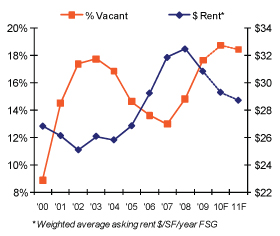 It’s a simple equation: The office market will not begin to recover until employers start hiring again. Friday’s employment report from the Labor Department showing that just 11,000 payroll jobs were eliminated in November and the unemployment rate fell from 10.2 to 10.0 percent is a hopeful sign, but one data point isn’t enough to change the outlook for a slow recovery. Expect office leasing market fundamentals to soften in 2010 with vacancy ending the year at 18.7 percent, up from 17.1 percent in 2009-Q3. The asking rental rate for Class A space is likely to fall another 5 percent next year. The market is expected to turn in 2011 as the vacancy rate embarks on a slow descent, though asking rent may slip a bit further due to the abundance of excess space that will remain on the market in the early stages of the recovery. Source: Grubb & Ellis
It’s a simple equation: The office market will not begin to recover until employers start hiring again. Friday’s employment report from the Labor Department showing that just 11,000 payroll jobs were eliminated in November and the unemployment rate fell from 10.2 to 10.0 percent is a hopeful sign, but one data point isn’t enough to change the outlook for a slow recovery. Expect office leasing market fundamentals to soften in 2010 with vacancy ending the year at 18.7 percent, up from 17.1 percent in 2009-Q3. The asking rental rate for Class A space is likely to fall another 5 percent next year. The market is expected to turn in 2011 as the vacancy rate embarks on a slow descent, though asking rent may slip a bit further due to the abundance of excess space that will remain on the market in the early stages of the recovery. Source: Grubb & Ellis
For a free consultation of your commercial real estate needs please contact Sean Thompson at 406.539.0082 or sean.thompson@grubb-ellis.com OR Joe Cobb at 406.579.2999 or joe.cobb@grubb-ellis.com. www.MTcommercialRE.com
 Leave a Comment » |
Leave a Comment » |  Market Reports | Tagged: Belgrade Buisness, Belgrade Commercial Real Estate, Belgrade Office, Bozeman, Bozeman Business, Bozeman Commercial Land, Bozeman Commercial Real Estate, Bozeman Real Estate, Bozeman Retail, Bozeman Warehouse, Commercial Investment, Commercial Real Estate, Commercial Real Estate Bozeman, Grubb & Ellis, Montana Business, Montana Commercial, Montana Commercial Real Estate, Montana Real Estate, Office For Lease, Office For Sale |
Market Reports | Tagged: Belgrade Buisness, Belgrade Commercial Real Estate, Belgrade Office, Bozeman, Bozeman Business, Bozeman Commercial Land, Bozeman Commercial Real Estate, Bozeman Real Estate, Bozeman Retail, Bozeman Warehouse, Commercial Investment, Commercial Real Estate, Commercial Real Estate Bozeman, Grubb & Ellis, Montana Business, Montana Commercial, Montana Commercial Real Estate, Montana Real Estate, Office For Lease, Office For Sale |  Permalink
Permalink
 Posted by Sean Thompson
Posted by Sean Thompson
 Consumers are getting back in the game. Total retail and food sales increased in January by 0.5 percent, seasonally adjusted, while core sales, which exclude autos and gas, rose by 0.6 percent. During the 12 months ending in January, total and core sales increased by 4.7 and 2.0 percent, respectively, with total sales boosted by the cash-for-clunkers program. Nevertheless, total sales remain 6.3 percent below their recent peak, and core sales are still down by 2.2 percent. As the labor market begins to improve, consumers will carefully ramp up their spending, including some purchases that were deferred during the depths of the recession. Consumer spending accounts for about 70 percent of total gross domestic product, so even a sluggish recovery in retail sales will help put a floor under the economy and reduce the chances for a double-dip recession. This will support leasing demand for commercial real estate, particularly shopping centers. Source: Census Bureau, Grubb & Ellis
Consumers are getting back in the game. Total retail and food sales increased in January by 0.5 percent, seasonally adjusted, while core sales, which exclude autos and gas, rose by 0.6 percent. During the 12 months ending in January, total and core sales increased by 4.7 and 2.0 percent, respectively, with total sales boosted by the cash-for-clunkers program. Nevertheless, total sales remain 6.3 percent below their recent peak, and core sales are still down by 2.2 percent. As the labor market begins to improve, consumers will carefully ramp up their spending, including some purchases that were deferred during the depths of the recession. Consumer spending accounts for about 70 percent of total gross domestic product, so even a sluggish recovery in retail sales will help put a floor under the economy and reduce the chances for a double-dip recession. This will support leasing demand for commercial real estate, particularly shopping centers. Source: Census Bureau, Grubb & Ellis


 Posted by Sean Thompson
Posted by Sean Thompson 






